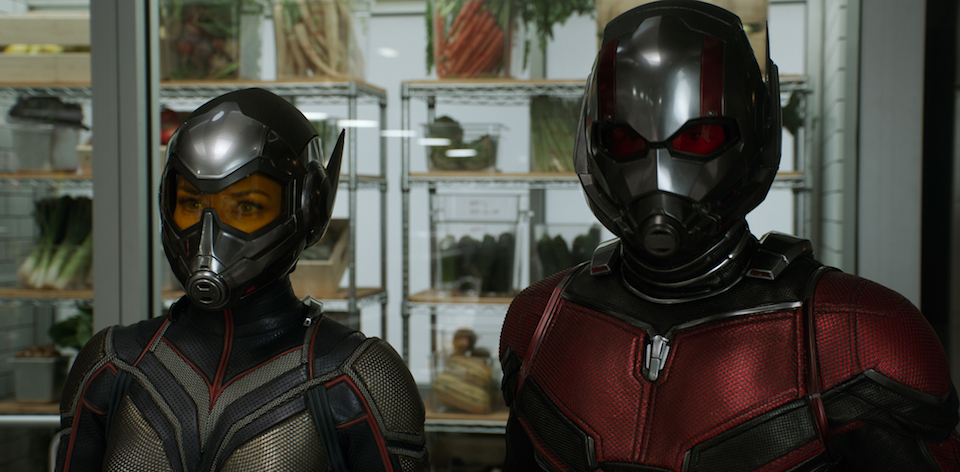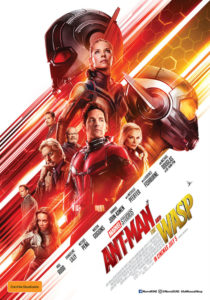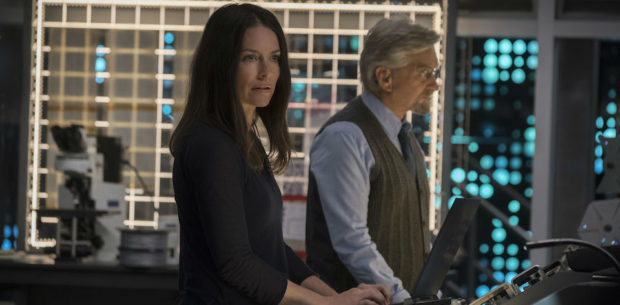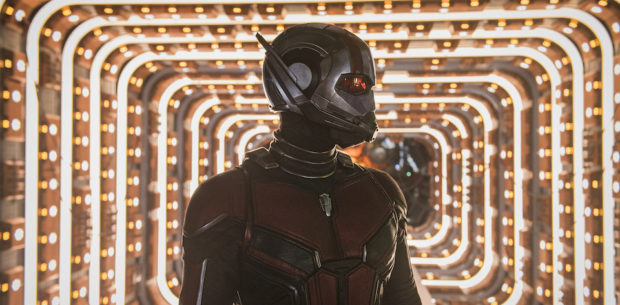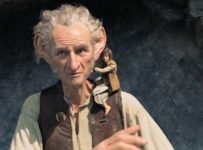The universe shattering Avengers: Infinity War was amazing, but it all started a decade ago with a single hero finding his way. With ANT-MAN AND THE WASP, the 20th film in the Marvel Cinematic Universe, we are returned to a kind of self-contained storytelling where the primary purpose is fun.
Following the events of Captain America: Civil War, Scott Lang (Paul Rudd) has been under house arrest. With only a few days left on his sentence, with plans to start a security firm with his old crew, he is drawn back into the lives of Hank Pym (Michael Douglas) and his daughter Hope (Evangeline Lilly). On the cusp of finding a way of rescuing Janet Van Dyne (Michelle Pfeiffer), lost in the Microverse 30 years before, their efforts are stymied with the sudden appearance of the Ghost (Hannah John-Kamen).
From the opening moments of the film, where Scott and his daughter engage an elaborate box fort game, director Peyton Reed’s key concept is “playful.” After the success of the Thomas the Tank Engine sequence in the original Ant-Man, the whole city of San Francisco and its surround is Peyton’s sandbox in this follow-up. Like Doctor Strange before it, the everyday world is merely a facade for the physics-defying action on display.
From the moment Lilly first dons the Wasp costume in the opening act, it’s also clear that this is a co-headlining film. Staggeringly, it’s taken Marvel a score of films for a female hero to be the titular lead. Her debut is one of the best and most inventive action sequences we’ve seen in a Marvel film to date, fully utilising the scale and elasticity of the heroes. The same motif is later used for comedic effect with Scott unable to control the regulation of his own size.
Yet when he does go big, both literally and figuratively, Peyton is fully in control of this ship. Old-school chases through the streets of San Francisco use embiggening and shrinking to distort our sense of scale, turning a simple chase into a discombobulating mind-melt. If ANT-MAN AND THE WASP gets tangled up anywhere, it’s in this excess. An entire subplot about a tech smuggler (played by Walton Goggins) could have been excised without any real detriment to the script.
Perhaps they were necessary due to Ghost and Pym’s former colleague Bill Foster (Laurence Fishburne) acting not so much as villains as tragic anti-heroes. Pym’s rivalry with Foster does allow Douglas to take more of a central role than expected. Pfeiffer, on the other hand, is a glorifed cameo, although she owns every inch of the screen when she’s on it. Nevertheless, this is almost Lilly’s film to carry, with Rudd being just one of the support crew she has available to her.
READ MORE: Where to Start: Ant-Man and the Wasp comics you should read
It also wouldn’t be an Ant-Man film without a barrel of humour to spare. Much of it comes from Rudd’s laconic wit and physicality, the rest from the wonderfully weird Michael Peña’s Luis. In one memorable sequence, he gives us the best Drunk History retelling of the last two years while under the influence of a “truth serum.”
Dedicated Marvel fans know that they should stick around for the credits, and this one is particularly important for anyone keen to get a little more Infinity War action. Filled with sight-gags and emotional moments in equal measure, ANT-MAN AND THE WASP shows us that the smallest heroes get to have the biggest amount of fun.
[stextbox id=”grey” bgcolor=”F2F2F2″ mleft=”5″ mright=”5″ image=”null”]2018 | US | DIR: Peyton Reed | WRITERS: Chris McKenna, Erik Sommers, Paul Rudd, Andrew Barrer, Gabriel Ferrari | CAST: Paul Rudd, Evangeline Lilly, Michael Peña, Walton Goggins, Bobby Cannavale, Judy Greer, Tip “T.I.” Harris, David Dastmalchian, Hannah John-Kamen | DISTRIBUTOR: Disney | RUNNING TIME: 118 minutes | RELEASE DATE: 5 July 2018 (AUS)[/stextbox]

